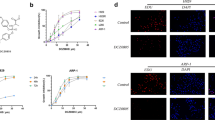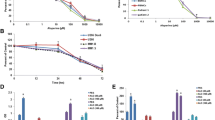Abstract
Despite recent advances in therapy, multiple myeloma, the second most common hematologic tumor in the Western world, is still incurable. Identification of substances that display a wide range of tumor-killing activities and target cancer-specific pathways constitute a basis for the development of novel therapies. In this study, we investigate the cytotoxic effect of the natural substance cnicin in multiple myeloma. Cnicin treatment reveals potent antiproliferative effects and induces cell death in cell lines and primary myeloma cells even in the presence of survival cytokines and the tumor microenvironment. Other cell lines of hematopoietic origin also succumb to cell death whereas stromal cells and endothelial cells are unaffected. We show that activation of caspases, accumulation of reactive oxygen species and downregulation of nuclear factor kappa-light-chain-enhancer of activated B cell contribute to the cytotoxic effects of cnicin. Microarray analysis reveals downregulation of Pim-2, a serine/threonine kinase. We provide evidence that Pim-2 constitutes a new survival kinase for myeloma cells in vitro and is highly expressed in malignant but not in normal plasma cells in vivo. Combining cnicin with current standard or experimental therapeutics leads to enhanced cell death. Thus, our data indicate that cnicin induces myeloma cell death via several pathways and reveals Pim-2 as a novel target. These findings provide a rational for further evaluation of cnicin as a new anti-tumor drug and underline the potential of sesquiterpene lactones in tumor therapy.





Similar content being viewed by others
References
Hideshima T, Chauhan D, Richardson P, Mitsiades C, Mitsiades N, Hayashi T, Munshi N, Dang L, Castro A, Palombella V et al (2002) NF-kappa B as a therapeutic target in multiple myeloma. J Biol Chem 277:16639–16647
Kawauchi K, Ogasawara T, Yasuyama M, Otsuka K, Yamada O (2009) The PI3K/Akt pathway as a target in the treatment of hematologic malignancies. Anticancer Agents Med Chem 9:550–559
Hideshima T, Akiyama M, Hayashi T, Richardson P, Schlossman R, Chauhan D, Anderson KC (2003) Targeting p38 MAPK inhibits multiple myeloma cell growth in the bone marrow milieu. Blood 101:703–705
Newman DJ, Cragg GM (2007) Natural products as sources of new drugs over the last 25 years. J Nat Prod 70:461–477
Bruno M, Rosselli S, Maggio A, Raccuglia RA, Bastow KF, Wu CC, Lee KH (2005) Cytotoxic activity of some natural and synthetic sesquiterpene lactones. Planta Med 71:1176–1178
Hung JY, Hsu YL, Ni WC, Tsai YM, Yang CJ, Kuo PL, Huang MS (2010) Oxidative and endoplasmic reticulum stress signaling are involved in dehydrocostuslactone-mediated apoptosis in human non-small cell lung cancer cells. Lung Cancer 68:355–365
Ichikawa H, Nair MS, Takada Y, Sheeja DB, Kumar MA, Oommen OV, Aggarwal BB (2006) Isodeoxyelephantopin, a novel sesquiterpene lactone, potentiates apoptosis, inhibits invasion, and abolishes osteoclastogenesis through suppression of nuclear factor-kappaB (nf-kappaB) activation and nf-kappaB-regulated gene expression. Clin Cancer Res 12:5910–5918
Lee J, Hwangbo C, Lee JJ, Seo J, Lee JH (2010) The sesquiterpene lactone eupatolide sensitizes breast cancer cells to TRAIL through down-regulation of c-FLIP expression. Oncol Rep 23:229–237
Lesiak K, Koprowska K, Zalesna I, Nejc D, Duchler M, Czyz M (2010) Parthenolide, a sesquiterpene lactone from the medical herb feverfew, shows anticancer activity against human melanoma cells in vitro. Melanoma Res 20:21–34
Saroglou V, Karioti A, Demetzos C, Dimas K, Skaltsa H (2005) Sesquiterpene lactones from Centaurea spinosa and their antibacterial and cytotoxic activities. J Nat Prod 68:1404–1407
Steele AJ, Jones DT, Ganeshaguru K, Duke VM, Yogashangary BC, North JM, Lowdell MW, Kottaridis PD, Mehta AB, Prentice AG et al (2006) The sesquiterpene lactone parthenolide induces selective apoptosis of B-chronic lymphocytic leukemia cells in vitro. Leukemia 20:1073–1079
Suvannasankha A, Crean CD, Shanmugam R, Farag SS, Abonour R, Boswell HS, Nakshatri H (2008) Antimyeloma effects of a sesquiterpene lactone parthenolide. Clin Cancer Res 14:1814–1822
Wang W, Adachi M, Kawamura R, Sakamoto H, Hayashi T, Ishida T, Imai K, Shinomura Y (2006) Parthenolide-induced apoptosis in multiple myeloma cells involves reactive oxygen species generation and cell sensitivity depends on catalase activity. Apoptosis 11:2225–2235
Vanhaelen-Fastre R, Vanhaelen M (1976) Antibiotic and cytotoxic activity of cnicin and of its hydrolysis products. Chemical structure–biological activity relationship. Planta Med 29:179–189 (author’s transl)
Schneider G, Lachner I (1987) Analysis and action of cnicin. Planta Med 53:247–251
Woodland RT, Fox CJ, Schmidt MR, Hammerman PS, Opferman JT, Korsmeyer SJ, Hilbert DM, Thompson CB (2008) Multiple signaling pathways promote B lymphocyte stimulator dependent B-cell growth and survival. Blood 111:750–760
Cohen AM, Grinblat B, Bessler H, Kristt D, Kremer A, Schwartz A, Halperin M, Shalom S, Merkel D, Don J (2004) Increased expression of the hPim-2 gene in human chronic lymphocytic leukemia and non-Hodgkin lymphoma. Leuk Lymphoma 45:951–955
Claudio JO, Masih-Khan E, Tang H, Goncalves J, Voralia M, Li ZH, Nadeem V, Cukerman E, Francisco-Pabalan O, Liew CC et al (2002) A molecular compendium of genes expressed in multiple myeloma. Blood 100:2175–2186
Asano J, Nakano A, Oda A, Amou H, Hiasa M, Takeuchi K, Miki H, Nakamura S, Harada T, Fujii S et al (2011) The serine/threonine kinase Pim-2 is a novel anti-apoptotic mediator in myeloma cells. Leukemia 25:1182–1188
Fox CJ, Hammerman PS, Cinalli RM, Master SR, Chodosh LA, Thompson CB (2003) The serine/threonine kinase Pim-2 is a transcriptionally regulated apoptotic inhibitor. Genes Dev 17:1841–1854
Amson R, Sigaux F, Przedborski S, Flandrin G, Givol D, Telerman A (1989) The human protooncogene product p33pim is expressed during fetal hematopoiesis and in diverse leukemias. Proc Natl Acad Sci U S A 86:8857–8861
Fox CJ, Hammerman PS, Thompson CB (2005) The Pim kinases control rapamycin-resistant T cell survival and activation. J Exp Med 201:259–266
Hammerman PS, Fox CJ, Birnbaum MJ, Thompson CB (2005) Pim and Akt oncogenes are independent regulators of hematopoietic cell growth and survival. Blood 105:4477–4483
Chen JL, Limnander A, Rothman PB (2008) Pim-1 and Pim-2 kinases are required for efficient pre-B-cell transformation by v-Abl oncogene. Blood 111:1677–1685
Allen JD, Verhoeven E, Domen J, van der Valk M, Berns A (1997) Pim-2 transgene induces lymphoid tumors, exhibiting potent synergy with c-myc. Oncogene 15:1133–1141
Zhang Y, Wang Z, Li X, Magnuson NS (2008) Pim kinase-dependent inhibition of c-Myc degradation. Oncogene 27:4809–4819
Breuer ML, Cuypers HT, Berns A (1989) Evidence for the involvement of pim-2, a new common proviral insertion site, in progression of lymphomas. EMBO J 8:743–748
Schatz JH, Oricchio E, Wolfe AL, Jiang M, Linkov I, Maragulia J, Shi W, Zhang Z, Rajasekhar VK, Pagano NC et al (2011) J Exp Med 208:1799–1807
Greenstein S, Krett NL, Kurosawa Y, Ma C, Chauhan D, Hideshima T, Anderson KC, Rosen ST (2003) Characterization of the MM.1 human multiple myeloma (MM) cell lines: a model system to elucidate the characteristics, behavior, and signaling of steroid-sensitive and -resistant MM cells. Exp Hematol 31:271–282
Rood PM, Calafat J, von dem Borne AE, Gerritsen WR, van der Schoot CE (2000) Immortalisation of human bone marrow endothelial cells: characterisation of new cell lines. Eur J Clin Invest 30:618–629
Deryugina EI, Quigley JP (2008) Chapter 2. Chick embryo chorioallantoic membrane models to quantify angiogenesis induced by inflammatory and tumor cells or purified effector molecules. Methods Enzymol 444:21–41
Kulterer B, Friedl G, Jandrositz A, Sanchez-Cabo F, Prokesch A, Paar C, Scheideler M, Windhager R, Preisegger KH, Trajanoski Z (2007) Gene expression profiling of human mesenchymal stem cells derived from bone marrow during expansion and osteoblast differentiation. BMC Genomics 8:70–76
Choi EJ, Ahn WS (2009) Antiproliferative effects of dehydrocostuslactone through cell cycle arrest and apoptosis in human ovarian cancer SK-OV-3 cells. Int J Mol Med 23:211–216
Kunzi-Rapp K, Genze F, Kufer R, Reich E, Hautmann RE, Gschwend JE (2001) Chorioallantoic membrane assay: vascularized 3-dimensional cell culture system for human prostate cancer cells as an animal substitute model. J Urol 166:1502–1507
Saw CL, Heng PW, Liew CV (2008) Chick chorioallantoic membrane as an in situ biological membrane for pharmaceutical formulation development: a review. Drug Dev Ind Pharm 34:1168–1177
Taizi M, Deutsch VR, Leitner A, Ohana A, Goldstein RS (2006) A novel and rapid in vivo system for testing therapeutics on human leukemias. Exp Hematol 34:1698–1708
Parada-Turska J, Paduch R, Majdan M, Kandefer.Szerszen M, Rzeski W (2007) Antiproliferative activity of parthenolide against three human cancer cell lines and umbilical vein endothelial cells. Pharmacol Rep 59:233–237
Zunino SJ, Storms DH, Ducore JM (2010) Parthenolide treatment activates stress signaling proteins in high-risk acute lymphoblastic leukemia cells with chromosomal translocation t(4;11). Int J Oncol 37:1307–1313
Clerkin JS, Naughton R, Quiney C, Cotter TG (2008) Mechanisms of ROS modulated cell survival during carcinogenesis. Cancer Lett 266:30–36
Amaravadi R, Thompson CB (2005) The survival kinases Akt and Pim as potential pharmacological targets. J Clin Invest 115:2618–2624
Zollinger A, Stuhmer T, Chatterjee M, Gattenlohner S, Haralambieva E, Muller-Hermelink HK, Andrulis M, Greiner A, Wesemeier C, Rath JC et al (2008) Combined functional and molecular analysis of tumor cell signaling defines 2 distinct myeloma subgroups: Akt-dependent and Akt-independent multiple myeloma. Blood 112:3403–3411
Dai H, Li R, Wheeler T, Diaz DV, Frolov A, Tahir S, Agoulnik I, Thompson T, Rowley D, Ayala G (2005) Pim-2 upregulation: biological implications associated with disease progression and perinueral invasion in prostate cancer. Prostate 65:276–286
Behan JW, Yun JP, Proektor MP, Ehsanipour EA, Arutyunyan A, Moses AS, Avramis VI, Louie SG, Butturini A, Heisterkamp N et al (2009) Adipocytes impair leukemia treatment in mice. Cancer Res 69:7867–7874
Ghantous A, Gali-Muhtasib H, Vuorela H, Saliba NA, Darwiche N (2010) What made sesquiterpene lactones reach clinical trials? Drug Discov Today 15:668–678
Merfort I (2011) Perspectives on sesquiterpene actones in inflammation and cancer. Curr Drug Targets 12:1560–1573
Curry EA 3rd, Murry DJ, Yoder C, Fife K, Armstrong V, Nakshatri H, O’Connell M, Sweeney CJ (2004) Invest New Drugs 22:299–305
Acknowledgments
The authors would like to thank Katrin Janke and Claudia Zavadil for their excellent technical assistance. This project was supported by grants of the Austrian Cancer Society/Tirol (to KJ, MO, and JP), the SFB021 (to RG), and the Klinische Malignom- und Zytokinforschung Innsbruck-Salzburg gemeinnützige GmbH.
Author information
Authors and Affiliations
Corresponding author
Electronic supplementary material
Below is the link to the electronic supplementary material.
ESM 1
DOC 35 kb
Rights and permissions
About this article
Cite this article
Jöhrer, K., Obkircher, M., Neureiter, D. et al. Antimyeloma activity of the sesquiterpene lactone cnicin: impact on Pim-2 kinase as a novel therapeutic target. J Mol Med 90, 681–693 (2012). https://doi.org/10.1007/s00109-011-0848-x
Received:
Revised:
Accepted:
Published:
Issue Date:
DOI: https://doi.org/10.1007/s00109-011-0848-x




